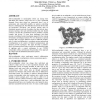215 search results - page 22 / 43 » Feature-based locomotion controllers |
SIGGRAPH
1993
ACM
14 years 21 days ago
1993
ACM
Sensor-actuator networks (SANs) are a new approach for the physically-based animation of objects. The user supplies the configuratíon of a mechanical system that hás been augmen...
SMC
2007
IEEE
14 years 2 months ago
2007
IEEE
– In this paper, we present a hierarchical methodology that learns new walking gaits autonomously while operating in an uncharted environment, such as on the Mars planetary surfa...
IROS
2006
IEEE
14 years 2 months ago
2006
IEEE
Telepresence offers considerable advantages in the remote execution of maintenance assignments. In this work a telepresence system is presented that allows to perform assembly tas...
CDC
2009
IEEE
13 years 6 months ago
2009
IEEE
The purpose of this paper is to estimate the position of a human in the image frame and to use this information to diagnose falls. A nonholonomic locomotion model describes the dis...
AGENTS
2000
Springer
14 years 29 days ago
2000
Springer
Self-reconfigurable or metamorphic robots can change their individual and collective shape and size to meet operational demands. Since these robots are constructed from a set of a...

